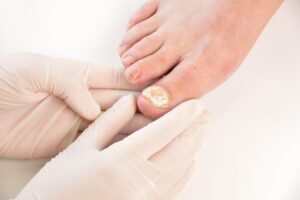Toenail fungus and pedicures in Beverly Hills can go hand in hand. Many people have gotten infected with a toenail fungus infection after getting a pedicure done. It is very important to be picky about the nail salons you visit to ensure you do no get infected with a toenail fungus infection.
Types of Toenail Fungus
Toenail fungus, or onychomycosis, can develop in several different forms. This depends on the type of fungus involved and how the infection spreads through the nail. The first and most common type is distal subungual onychomycosis. It occurs when dermatophyte fungi invade the nail bed from the tip or sides of the nail. This form typically begins with a yellow or white spot near the edge of the nail. It then gradually spreads inward, causing the nail to thicken, discolor, and crumble at the edges. Because it affects the underside of the nail, it can be difficult to treat and often requires long-term therapy.
The second type, known as white superficial onychomycosis, is caused by fungi that attack only the surface of the nail plate. This results in white, chalky patches on the nail’s surface that can often be scraped away. It tends to progress more slowly. It is usually easier to treat since the infection does not penetrate deeply into the nail.
A third and less common form is proximal subungual onychomycosis, which begins at the base of the nail near the cuticle and spreads upward as the nail grows. This type is often associated with weakened immune systems. It is also associated with other underlying health conditions and may signal a more serious systemic issue.
Less common types of toenail fungus infections:
A fourth and rare form, candida onychomycosis, is caused by yeast rather than dermatophyte fungi. It typically affects fingernails more than toenails. It causes swelling, redness, or even separation of the nail from the nail bed.
Finally, the fifth type is a total dystrophic onychomycosis is considered the end stage of long-standing infection. The nail becomes completely discolored, thickened, and deformed. Recognizing the specific type of toenail fungus is important because it helps determine the most effective treatment. Whether it is topical, oral, or laser-based, it improves the likelihood of achieving clear, healthy nails.

How pedicures can lead to toenail fungus
Toenail fungus thrives in warm, moist environments, making nail salons potential hotspots if they aren’t properly cleaned and sanitized. Here are common ways toenail fungus can spread:
-
Unsanitized Foot Baths: If foot baths aren’t cleaned thoroughly between clients, fungal spores can live in the water and transfer to your feet.
-
Shared Tools: Nail clippers, nail files, and buffers can spread fungus from one person to another if they aren’t properly sterilized between uses.
-
Aggressive Cuticle Cutting: Cuticles protect the nail bed. Cutting or pushing them back too harshly can create tiny openings for fungus to enter.
-
Polish Bottles Used on Multiple Clients: The brush from a shared polish bottle can pick up fungal spores from one person and transfer them to the next.
-
At-Home Pedicure Risks: Even at home, using dirty tools, soaking feet in reused water, or cutting cuticles too closely can increase your risk.
Once fungus enters the nail, it can be stubborn. A fungus infection leads to brittle, discolored nails that are difficult to treat without professional help.
Do I have to stop getting pedicures?
You don’t have to give up pedicures forever to protect your nail health. Here’s how to reduce your risk:
-
Choose a clean, licensed Salon: Look for salons that use hospital-grade sterilization and disposable liners in foot baths.
-
Avoid shaving before pedicures: Shaving can create tiny cuts on your legs, making it easier for fungus to enter.
-
Say no to aggressive cuticle cutting: Ask your technician to gently push back cuticles rather than cutting them.
-
Use flip-flops in the salon: Avoid letting your bare feet touch communal surfaces.
-
Consider skipping polish during treatment: If you’re dealing with a fungal infection or undergoing treatment, keeping nails bare helps you monitor progress and keeps the area clean.

Laser Treatment for a Toenail Fungus in Beverly Hills
Toenail fungus treatments in Glendale can vary. If you have caught nail fungus, it can be easily treated using the FDA-approved PinPointe laser, which typically only takes one treatment. Other treatments like topical solutions and oral medication are not as effective. Topical solutions have a very low cure rate. This is because the solution does not penetrate all the way through the nail bed. Oral medication has a higher cure rate than topicals, but our nail doctors do not recommend it. This is because it can lead to liver toxicity. You would need to have consistent blood tests throughout the course of taking the medication.
Our nail doctor in Beverly Hills, CA recommends this treatment for toenail fungus. The PinPointe Laser treatment has the highest cure rate in the market. It has no side effects and no recovery period. As a result, you can go about your daily activities right after the treatment. Also, there’s no pain.
If you have any signs of nail fungus, call us at 800-672-0625 at our Beverly Hills, CA location, or visit our website for more information on our doctors at one of our over 150 locations.




